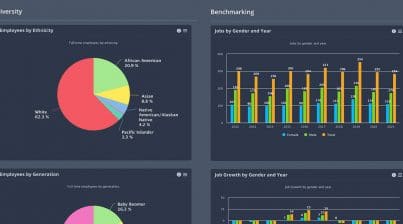If you’ve been in the workforce for at least the past 20 years, you most likely are aware of what an annual review is. Part meeting, part report card, these two-person conferences are held with a worker and their direct supervisor and chronicle the successes and failures of an employee’s previous work year. With any luck, the meeting would culminate in a raise and a firing in a worst-case scenario.
An annual review, at its best, gives leadership a good sense of who their stand-out employees are and allows compensation adjustments. Unfortunately, the review process also rated employees on a curve, comparing them. Sometimes it was called “yank and rank.” Naturally, problems arose. Some workers felt it pitted employees against each other and created a toxic work environment. Others said it did not reward improvement and left most employees withering in the shadow of a “unicorn,” or boss’ favorite.
So it is no surprise that something had to change. A Deloitte survey of business owners found fully 70 percent reported that they were either “currently evaluating” or had recently “reviewed and updated” their performance management systems.
“They, and we, are in need of something nimbler, real-time, and more individualized,” the report read. “Something squarely focused on fueling performance in the future rather than assessing it in the past.”
And this is where performance management began to evolve. One of the many problems of giving feedback once every 12 months is that no one wants to hear about a great mistake they made months ago. An employee is more likely to improve if errors are addressed right after they happen.
A New Way of Measuring Performance
In came the next revolution of Performance Management: ongoing discussions. Rather than monitoring performance once a year, continuous performance development is a concept many organizations have adopted. This is a practice of measuring each worker’s performance by a set of standards expected for their role.
Continuous performance development has a coaching mindset rather than a punitive one. Managers are asked to address performance issues with curiosity, not accusations. For example, if a worker frequently misses deadlines, a manager could ask, “How can I help you meet deadlines better?”
These ongoing meetings matter. More than 50 percent of existing employees surveyed by Gallup recently said that no one at the company spoke to them about how they were doing in their role in the three months before they decided to leave. That included their managers.
And worse, 52 percent of those employees said management could have changed their minds about leaving if only they had asked.
Another term you may be hearing is “strengths-based coaching.” This is a strategy of over time, making note of employee strengths and steering them toward roles that utilize those skills. You may find that your lowest-performing sales team member would be a star in customer success.
So the reverse of that is identifying areas of weakness and creating a plan to address those weaknesses.
These are some of the challenges organizations face when trying to measure performance. In 2022, post-pandemic, these challenges are even more significant. Now, most companies employ remote workers, people they see only on video calls once in a while.
Remote versus Hybrid Work Expectations
To support retention, employees need to be trusted more if they’re remote. But how do you balance that with the company’s need to measure output?
You can develop a hybrid model, where employees come into an office a few days a week but work the other days remotely. However, in a recent podcast, most employees want to go into an office less than three times a week, said Amy Yin, founder and CEO of Officetogether.
She said that a hybrid work culture needs to continue to track and monitor success. Data can be stored on which employees are coming into the office and which are choosing to work from other locations.
“When it comes time to do a performance review, you can see how rating and performance are ranked – for folks in the office, fully remote, or in between. It all comes back to the data.”
How to Build Employee Trust
It cannot be understated in the 2022 working landscape:
- Over-communicate. Listen to your employees about what is working. Consider hosting informal “hangouts” once in a while for team members to bond and relax around one another.
- Lead with empathy. Keep in mind that the COVID-19 pandemic turned workplaces virtually upside down in 2020, and everyone is still trying to make sense of it. Remote work is not ideal for everyone. Outgoing people or those who live alone can have a very tough adjustment to remote work.
- Give employees a lot of leeways. If you trust your employees to get their work done, you don’t need to be mico-managing the hours they spend at their desks. Adopt an output versus hours-worked mindset. Working long hours doesn’t always mean an employee is productive.
Continuing performance management is a much more time-consuming process than the old system. Not only are your employees expecting more feedback and coaching, but new performance management requires extra data, such as feedback from co-workers and clients. This method helps reduce direct manager bias for or against certain workers.
The data you gather in performance management comes in many forms. You may have workers complete a self-evaluation, asking them to evaluate how they perform. This can be compared with a manager’s evaluation to see areas of overlap.
Graphic rating scales are popular in rating performance. For example, rating employees on a numerical scale of 1 to 10 on various aspects of their job, such as arriving on time to meetings or following up on sales calls.
Create a system of concrete objectives so that managers and employees know long ahead what is expected of them. This is called Management by Objectives or Management by Results and involves the employee in crafting his or her own set of goals, in alignment with the company. With so much work and planning put into this system, employees are likely to be much more motivated and engaged than they would be otherwise.
Quality of work is also an important HR metric to measure. While production is important, there are other values that quality work brings to the organization, such as repeat customers, and good reviews. Make sure complaints and compliments are being tracked and measured to see which of your workers are doing an outstanding job and could be moved into more prominent roles.
Establishing More and Better Data Sets
Once your organization commits to establishing ongoing performance management, more data will come in, and faster. This will allow more effective analysis, almost like having snapshots in time rather than a single evaluation of a year of work. It will be able to see the skills in which employees are strong as well as how fast they are improving in weaker areas.
The old way is gone, and the new way requires a lot of data and note-taking. You cannot do with a collection of disjointed spreadsheets in 10 different programs. Data can’t be analyzed effectively if it’s scattered left and right.
Many businesses want to improve and strengthen their performance management in 2022 but don’t know-how.
Discover how Employee Cycle’s dashboard can help you visualize and advance your human resources programs today and how having metrics at your fingertips will help you attract, retain, and fairly reward talent in the workplace. Schedule a free demo today.












